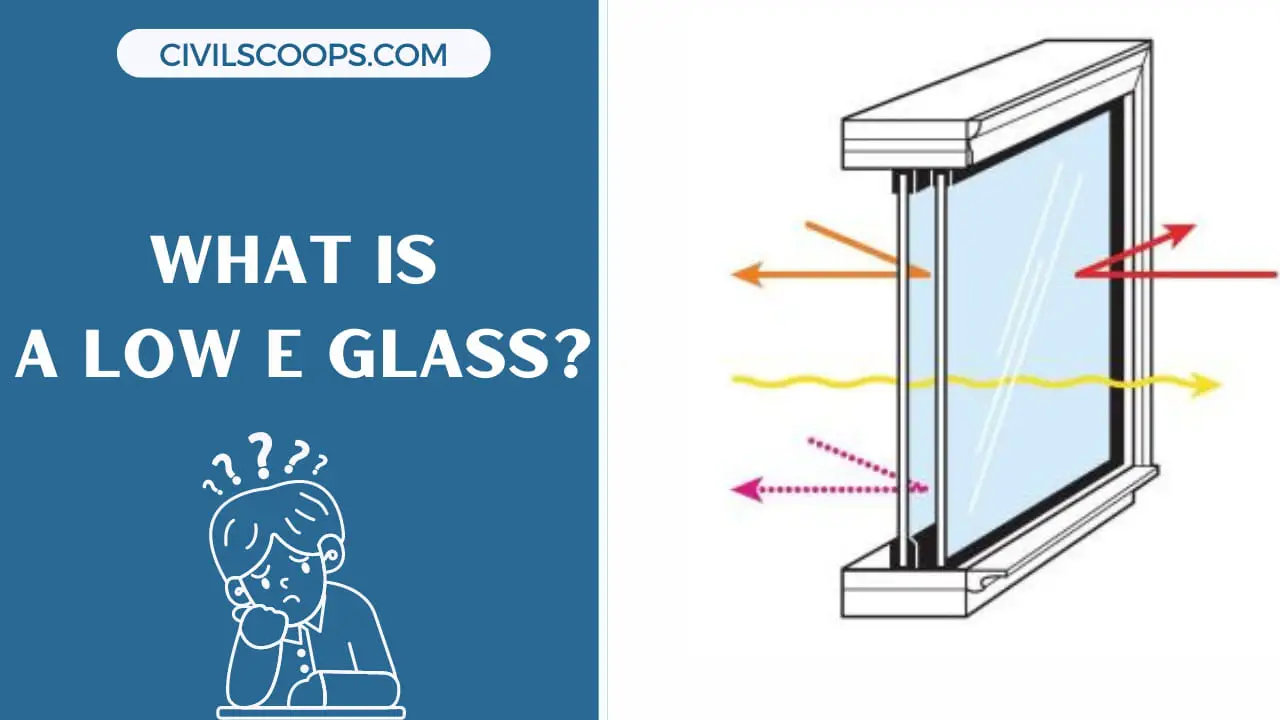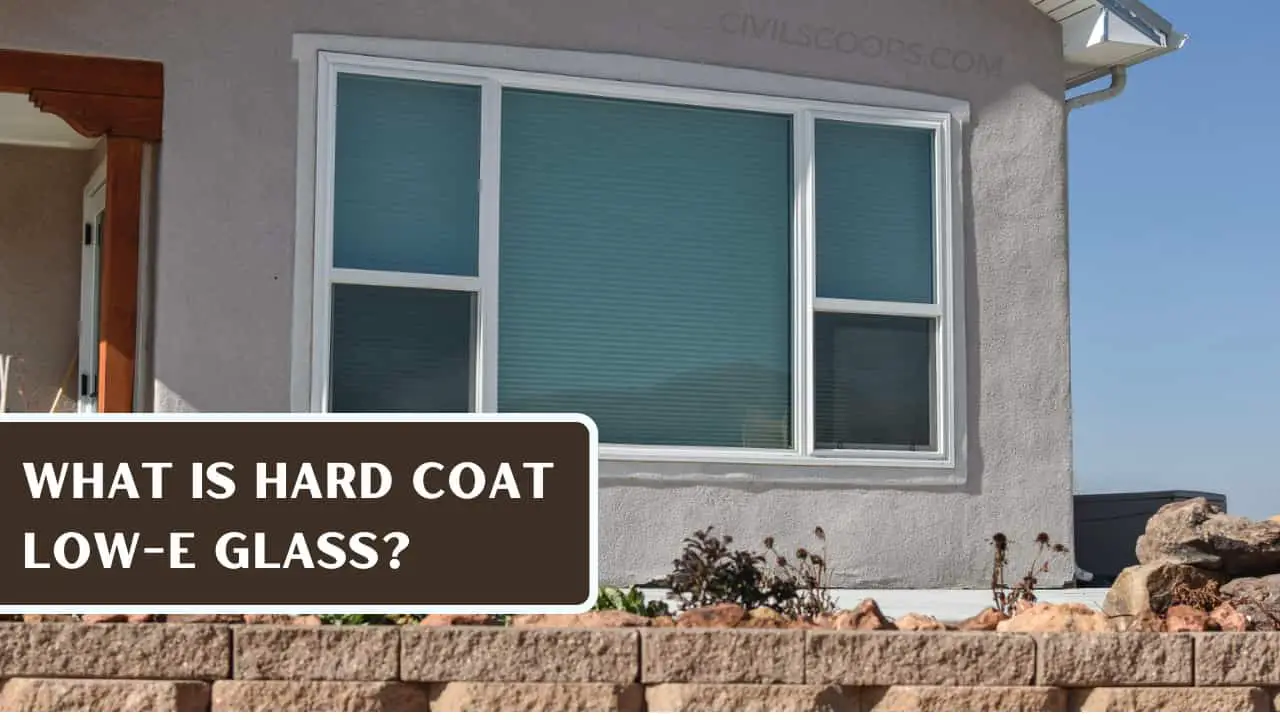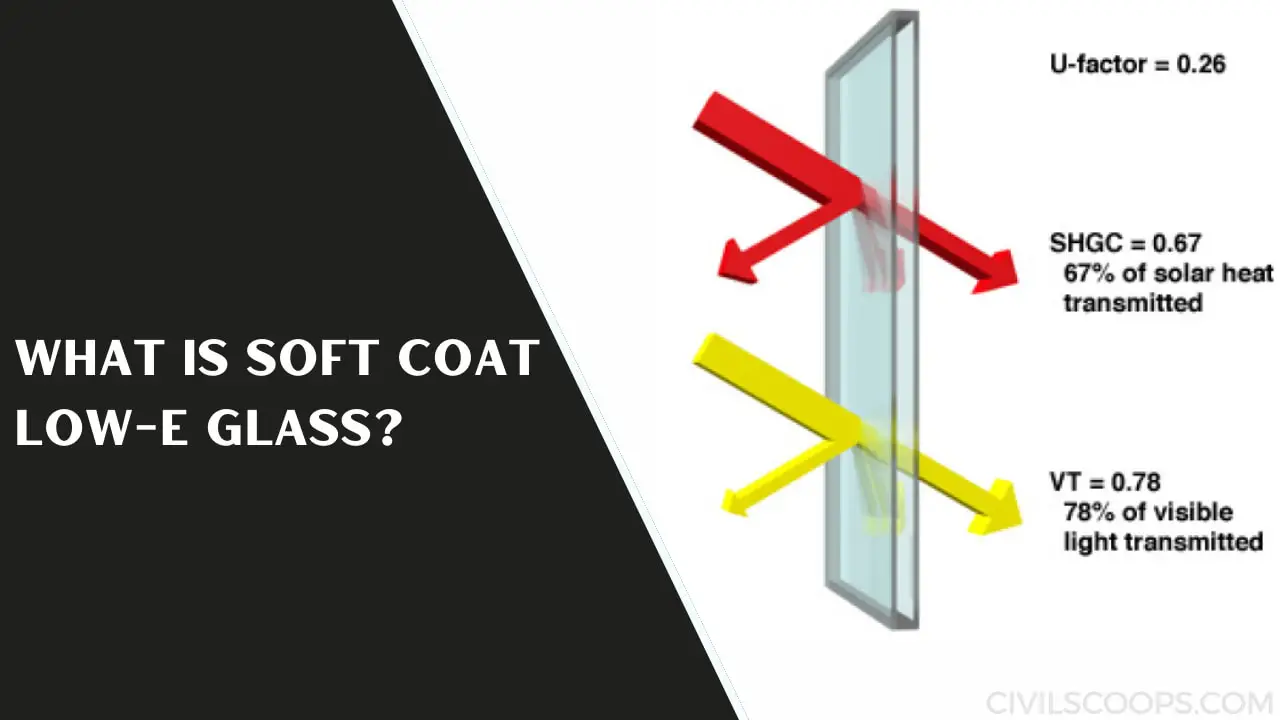What Is a Low E Glass | Types of Low E Glass | Advantages & Disadvantages of Low E Glass

Table of Contents
What Is a Low-E Glass?

Low-E Glass full name Low-Emissivity Glass, glass was created to minimize the amount of infrared and ultraviolet light that comes through your glass, without minimizing the amount of light that enters your home.
Low-E glass windows have a microscopically thin coating that is transparent and reflects heat. The coating is even thinner than human hair! The Low-E coatings keep the temperature in your home consistent by reflecting the interior temperatures back inside.
Also Read: How to Calculate Steel in RCC Slab
Types of Low E Glass
There are two types of Low-E glass:
- Hard coat (online)
- Soft coat (offline).
Hard coat Low-E glass
Hard coat Low-E glass is made by coating the glass during production with a thin metallic oxide layer, effectively welding it to the glass surface.
Soft coat Low-E glass
Soft coat Low-E glass, or sputter coating, is applied to glass that has already been formed.
Advantages of Low E Glass
Low E Glass Reduce Energy Costs
- Low-E glass has an invisible coating that reflects long-wave infrared radiations towards the interior of the building.
- They keep the interiors cooler in summer and warmer in winter months; effectively decreasing the use of energy appliances by controlling the indoor temperature.
Low E Glass Reduce Destructive UV Rays
- Because it resists ultraviolet light, low-E glass prevents sunlight exposure from damaging carpets, draperies, sofas, and other furnishings.
- And, low-E glass reduces sunlight glare in a room. The coatings reduce glare and reflect the sun’s heat away from the structure.
Low E Glass Do Not Block All Natural Light - Low E windows block infrared light and UV light, but one other vital component makes up the solar spectrum, visible light. Of course, they will reduce visible light slightly, compared to a clear glass pane. However, plenty of natural light will brighten your room.
Low E Glass Reducing Electricity
- They help in reducing electricity bills, as they maintain the temperature of the room at the desired level.
Low E Glass Compared to Normal Glass
- Low e-glass provides better performance as compared to single glazing glass and double glazing glass. So it is extensively used in glass facades in cold climates.
Disadvantages of Low E Glass
- One of the disadvantages of Low-E glass is that it is more expensive than regular glass.
- Windows that are designed to block out UV rays and infrared light are generally going to be more costly than traditional windows.
- This means that you will have a larger initial investment to deal with.
What Is Hard coat Low-E Glass?

Hard Coat Low E is applied at a very high temperature and is sprayed onto the glass surface. The advantage of a hard coat is that it can be tempered after the coating application, and it offers to accessorize with the glass, such as blinds in between the panes.
Also Read: Grey Water vs Black Water | What Is Grey Water | What Is Black Water
What Is Soft coat Low-E Glass?

Soft Coat Low E uses a thin layer of silver, applied using a ‘sputter’ process to a pre-cut section of glass in a vacuum chamber at room temperature. The finish is referred to as ‘soft coat’ as the coating remains fairly delicate (which is why soft coat is always found on face two or three).
[su_box title=”FAQ” style=”default” box_color=”#333333″ title_color=”#FFFFFF” radius=”3″ class=”” id=””]
Low-E Glass Price
A Low-E window glass price will generally be around $14 per square foot. Additionally, in the long run, Low-E coatings will help you save money on energy bills.
Low E Glass Cost
Low-e windows offer the warmest glass temperatures in winter, which offers the highest occupant comfort. Based on national averages from RSMeans data, removing existing dual-pane windows and replacing them with dual-pane Low-E glass costs between $40 and $55 per square foot.
E Glass Price
A Low-E window glass price will generally be around $14 per square foot. Additionally, in the long run, Low-E coatings will help you save money on energy bills.
E Glass Cost
Based on national averages from RSMeans data, removing existing dual-pane windows and replacing them with dual-pane Low-E glass costs between $40 and $55 per square foot. Adding Low-E dual pane glass offers somewhat greater energy savings than either type of window film but at a much higher initial investment.
Is Low-E Glass Worth It
Low-e glass options are definitely worth the investment. For just a few more dollars than standard glass, you get energy savings and protection from Low-E glass. And that little extra cost can pay for itself with the money you’ll save on utility bills!
Is Low E Glass Worth It on Storm Door
In addition to energy savings, Low-E glass protects from fading. Think about all the sunlight that comes into your entryway. Having Low-E glass on your storm door and storm windows helps reduce fading on hardwood floors and curtains.
Low E Glass Inside or Outside
inside
Low-E Insulated units should be glazed with the Low-E facing on the outside and clear on the inside.
Does Low E Glass Go Inside or Outside
The Low-E coating is usually placed on one of the inside glass pane surfaces of the insulating unit. Homeowners can test for the Low-E coating in a window by doing the following: Hold a lit match or a pen light up in front of the window.
Soft Coat Glass Inside or Outside
For single pane windows, it is recommended the Low-E coating is always placed on the inside facing surface. Low-e coatings are sensitive to weather and pollutants, making them difficult to clean without damaging the surface.
Does Low-E Glass Look Different
If the window contains Low-E glass, one of the images will be a different color than the rest of the images. If the window does not have Low-E glass, the four reflected images will be the same color.
Low-E Glass Benefits
Low E applied to windows helps block infrared light from penetrating the glass from the outside. In addition, Low E helps keep in your heating/cooling energy. Bottom line: they are much more energy-efficient, helping you save on heating and cooling costs and costs associated with running your heating/cooling systems.
Low E Glazing Benefits
Low-e glass helps keep unwanted UV rays out of your home that can damage your skin and furniture. It also helps control the amount of infrared light that enters and leaves the room. Windows without Low-E won’t be able to effectively keep harmful light out of your home, which can contribute to higher energy bills.
Low-E Glass Cost Vs. Regular
Low-e window film can be installed in most commercial spaces for between $5 and $8 per square foot. Some recently introduced high visible light transmission Low-E films (70% visible transmission) are more expensive, with installed costs of $12 to $15 per square foot.
Can Low E Glass Be Installed Backwards
The Low E Glass helps to reduce the amount of energy that escapes or enters the room. This is because a low E glass can be installed backward, which means that it can stop the energy flow from either side.
Low-E Coating on Which Surface
Passive Low-E coatings function best when on the third or fourth surface (furthest away from the sun), while solar control Low-E coatings function best when on the lite closest to the sun, typically the second surface.
What Surface Should the Low E Coating Be on
Passive Low-E coatings function best when on the third or fourth surface (furthest away from the sun), while solar control Low-E coatings function best when on the lite closest to the sun, typically the second surface.
Is Low-E Glass Worth It on Storm Door
In addition to energy savings, Low-E glass protects from fading. Think about all the sunlight that comes into your entryway. Having Low-E glass on your storm door and storm windows helps reduce fading on hardwood floors and curtains.
How Much Difference Does Low E Glass Make
However, low-E windows can produce significant savings over time. Energy loss from heat conduction can be reduced by as much as 50% with low-E coatings. In other words, homeowners who install low-E windows on their property can make back the extra money they spend.
Why Do Low-E Windows Look Green?
“If you had low-e material in a white 5-gallon bucket, it’s translucent with a light green hue. Since that material is spatter-coated on the insulated glass when an energy-efficient window is being manufactured, more splatter creates more of that green hue.
Is Smart Glass Expensive
Smart glass costs around $25 to $150 per square foot, with an average cost of $100. The price depends on the total square footage, with single units running up to $50 per square foot more than you’d pay to install several.
Is Switchable Glass Expensive
Switchable glass—which can refer to PDLC, SPD, or electrochromic products—costs around $50 to $150 per square foot and includes all materials and installation. You can apply smart film to existing windows, and it’s less expensive at around $25 to $50 per square foot.
What Is Low-E 3 Glass?
Low-E3 windows are another industry term that simply reflects the application of three coats of metal onto a window. This style of window tends to be a great all-climate window because it offers great performance in colder weather (U-Factor) and enhanced performance in summer (SHGC).
Can You Use Windex on Low-E Glass
Consequently, it is recommended that Windex® glass and surface cleaner (clear liquid) is used as this will minimize smearing. Do not use ammonia-based glass cleaners or alcohol-based cleaners, as these will leave smears on the glass.
Types of Low E Glass
There are two types of low-e glass: hard coat (online) or soft coat (offline). Hard coat low-e glass is made by coating the glass during production with a thin metallic oxide layer, effectively welding it to the glass surface. Soft coat low-e glass, or sputter coating, is applied to glass that has already been formed.
Low E Glass Price
A low-e window glass price will generally be around $14 per square foot. Additionally, in the long run, low-e coatings will help you save money on energy bills.
Low E Coating Types
There are two types of Low E coatings – Hard Coat Low E and Soft Coat Low E. A hard-coat Low E glass is a version of the coating which is applied to the glass when it is just coming out of the furnace.
Why Do My New Windows Have a Blue Tint
In general, Low-E is invisible to the naked eye. However, if a part of the glass is in the shade while another part is exposed to very bright light, the part exposed to light may appear bluish in color and seem slightly blurry. The effect is normal and very temporary.
[/su_box]
[su_note note_color=”#F2F2F2 ” text_color=”#333333″ radius=”3″ class=”” id=””]
Like this post? Share it with your friends!
Suggested Read –
- PVB Vs. SGP | What Is Limited Glass | What Is Polyvinyl Butyral (PVB) | What Is Sentry Glass Plus (SGP)
- Difference Between Coarse-Grained Soil and Fine-Grained Soil | What Is Coarse-Grained Soil | What Is Fine-Grained Soil
- Well Point System | Types of Well Point System | Well Point Dewatering | PVC Well Point | Well Point Installation | Well Point for Shallow Well
- Types of Crawl Space Insulation | Fiberglass Batt Insulation | Closed Cell Spray Foam Insulation | Open-Cell Foam Spray Insulation | Rigid Foam Insulation and Use|
- Concrete Release Agent | Concrete Form Release Agent | Concrete Formwork Release Agent | Concrete Form Release Oil | Concrete Mold Release Agent | Homemade Concrete Release Agent | Concrete Release Agent for Wood | How to Keep Concrete from Sticking to Wood | Fiberglass Release Agent |
[/su_note]
Originally posted 2022-09-07 11:15:01.
